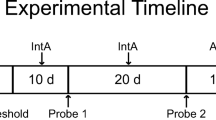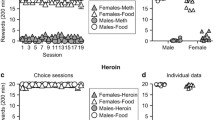Abstract
Rationale
Women meet criteria for substance use disorder after fewer years of drug use than men; this accelerated time course, or telescoping effect, has been observed for multiple drugs, including cocaine. Preclinical findings similarly indicate an enhanced vulnerability in females to developing an addiction-like phenotype; however, it is not yet known if this phenotype develops faster in females versus males.
Objectives
The goal of this study was to determine using a rat model whether two key features of addiction in humans, an enhanced motivation for cocaine and compulsive use, emerge sooner during withdrawal from extended access cocaine self-administration in females versus males.
Methods
Motivation for cocaine, as assessed under a progressive-ratio reinforcement schedule, was determined prior to and following extended access cocaine self-administration (24 h/day, 96 infusions/day, 10 days) and after 7, 14, or 60 days of withdrawal. Compulsive use, or use despite punishment, was evaluated once progressive-ratio responding stabilized by adding histamine, an aversive stimulus, to the cocaine solutions.
Results
Motivation for cocaine increased from baseline sooner during withdrawal in females than males (at 7 versus 14 days); motivation was also highest in the 60-day group. Histamine decreased progressive-ratio responding for cocaine in both sexes, although effects were greatest in males in the 7-day withdrawal group; males reached the female-level of resistance to histamine punishment by 14 days of withdrawal.
Conclusions
Female rats developed addition-like features sooner during withdrawal than male rats indicating that the telescoping effect observed in humans is biologically based. Additionally, like drug-seeking/craving, motivation for cocaine and measures of compulsive use incubate over withdrawal.






Similar content being viewed by others
References
Algallal H, Allain F, Ndiaye NA, Samaha AN (2020) Sex differences in cocaine self-administration behaviour under long access versus intermittent access conditions. Addict Biol 25:e12809
Anglin M, Hser Y, McGlothlin W (1987) Sex differences in addict careers. 2. Becoming addicted. Am J Drug Alcohol Abuse 13:59–71
Back SE, Payne RL, Wahlquist AH, Carter RE, Stroud Z, Haynes L, Hillhouse M, Brady KT, Ling W (2011a) Comparative profiles of men and women with opioid dependence: Results from a national multisite effectiveness trial. Am J Drug Alcohol Abuse 37:313–323
Back SE, Lawson KM, Singleton LM, Brady KT (2011b) Characteristics and correlates of men and women with prescription opioid dependence. Addict Behav 36:829–834
Bakhti-Suroosh A, Nesil T, Lynch WJ (2019) Tamoxifen blocks the development of motivational features of an addiction-like phenotype in female rats. Front Behav Neurosci 13:253
Becker JB, Koob GF (2016) Sex differences in animal models: focus on addiction. Pharmacol Rev 68:242–263
Binswanger IA, Stern MF, Deyo RA, Heagerty PJ, Cheadle A, Elmore JG, Koepsell TD (2007) Release from prison–a high risk of death for former inmates. N Engl J Med 356:157–165
Binswanger IA, Nowels C, Corsi KF, Glanz J, Long J, Booth RE, Steiner JF (2012) Return to drug use and overdose after release from prison: a qualitative study of risk and protective factors. Addict Sci Clin Pract 7:3
Brady KT, Randall CL (1999) Gender differences in substance use disorders. Psychiatr Clin North Am 22:241–252
Carroll ME, Morgan AD, Anker JJ, Perry JL, Dess NK (2008) Selective breeding for differential saccharin intake as an animal model of drug abuse. Behav Pharmacol 19:435–460
Center for Substance Abuse Treatment. (2009). ‘‘Substance abuse treatment: addressing the specific needs of women,’’ in SAMHSA/CSAT Treatment Improvement Protocols, (Rockville, MD: Substance Abuse and Mental Health Services Administration (US)), 1–48
Doyle SE, Ramôa C, Garber G, Newman J, Toor Z, Lynch WJ (2014) A shift in the role of glutamatergic signaling in the nucleus accumbens core with the development of an addicted phenotype. Biol Psychiatry 76:810–815
Ducret E, Puaud M, Lacoste J, Belin-Rauscent A, Fouyssac M, Dugast E, Murray JE, Everitt BJ, Houeto JL, Belin D (2016) N-Acetylcysteine facilitates self-imposed abstinence after escalation of cocaine intake. Biol Psychiatry 80:226–234
Elman I, Karlsgodt KH, Gastfriend DR (2001) Gender differences in cocaine craving among non-treatment-seeking individuals with cocaine dependence. Am J Drug Alcohol Abuse 27:193–202
Fitch TE, Roberts DC (1993) The effects of dose and access restrictions on the periodicity of cocaine self-administration in the rat. Drug Alcohol Depend 33:119–128
Gancarz-Kausch AM, Adank DN, Dietz DM (2014) Prolonged withdrawal following cocaine self-administration increases resistance to punishment in a cocaine binge. Sci Rep 4:6876
Greenfield SF, Back SE, Lawson K, Brady KT (2010) Substance abuse in women. Psychiatr Clin North Am 33:339–355
Griffin ML, Weiss RD, Mirin SM, Lange U (1989) A comparison of male and female cocaine abusers. Arch Gen Psychiatry 46:122–126
Grimm JW, Hope BT, Wise RA, Shaham Y (2001) Neuroadaptation. Incubation of cocaine craving after withdrawal. Nature 412:141–142
Haas AL, Peters RH (2000) Development of substance abuse problems among drug-involved offenders: evidence for the telescoping effect. J Subst Abuse 12:241–253
Hedegaard H, Minino, Arialdi, Warner, Margaret (2020). Drug overdose deaths in the United States, 1999–2018. NCHS Data Brief 1–8
Hernandez-Avila CA, Rounsaville BJ, Kranzler HR (2004) Opioid-, cannabis- and alcohol-dependent women show more rapid progression to substance abuse treatment. Drug Alcohol Depend 74:265–272
Hser Y, Anglin M, McGlothlin W (1987a) Sex differences in addict careers. 3. Addiction Am J Drug Alcohol Abuse 13:231–251
Hser Y, Anglin M, McGlothlin W (1987b) Sex differences in addict careers. 1. Initiation of use. Am J Drug Alcohol Abuse 13:33–57
Holtz NA, Anker JJ, Regier PS, Claxton A, Carroll ME (2013) Cocaine self-administration punished by i.v. histamine in rat models of high and low drug abuse vulnerability: effects of saccharin preference, impulsivity, and sex. Physiol Behav 122:32–38
Kawa AB, Robinson TE (2019) Sex differences in incentive-sensitization produced by intermittent access cocaine self-administration. Psychopharmacology 236:625–639
Kennedy AP, Epstein DH, Phillips KA, Preston KL (2013) Sex differences in cocaine/heroin users: drug-use triggers and craving in daily life. Drug Alcohol Depend 132:29–37
Li X, Caprioli D, Marchant NJ (2015) Recent updates on incubation of drug craving: a mini-review. Addict Biol 20:872–876
Lipman ZM, Yosipovitch G (2021) Substance use disorders and chronic itch. J Am Acad Dermatol 84:148–155
Lynch WJ (2008) Acquisition and maintenance of cocaine self-administration in adolescent rats: effects of sex and gonadal hormones. Psychopharmacology 197:237–246
Lynch WJ, Arizzi MN, Carroll ME (2000) Effects of sex and the estrous cycle on regulation of intravenously self-administered cocaine in rats. Psychopharmacology 152:132–139
Lynch WJ, Carroll ME (2000) Reinstatement of cocaine self-administration in rats: sex differences. Psychopharmacology 148:196–200
Lynch WJ, Mangini LD, Taylor JR (2005) Neonatal isolation stress potentiates cocaine seeking behavior in adult male and female rats. Neuropsychopharmacology 30:322–329
Lynch WJ, Piehl KB, Acosta G, Peterson AB, Hemby SE (2010) Aerobic exercise attenuates reinstatement of cocaine-seeking behavior and associated neuroadaptations in the prefrontal cortex. Biol Psychiatry 68:774–777
Lynch WJ, Taylor JR (2004) Sex differences in the behavioral effects of 24-h/day access to cocaine under a discrete trial procedure. Neuropsychopharmacology 29:943–951
Lynch WJ, Taylor JR (2005) Decreased motivation following cocaine self-administration under extended access conditions: effects of sex and ovarian hormones. Neuropsychopharmacology 30:927–935
Mayo LM, Paul E, DeArcangelis J, Van Hedger K, de Wit H (2019) Gender differences in the behavioral and subjective effects of methamphetamine in healthy humans. Psychopharmacology 236:2413–2423
McCance-Katz EF, Carroll KM, Rounsaville BJ (1999) Gender differences in treatment-seeking cocaine abusers—implications for treatment and prognosis. Am J Addict 8:300–311
Morgan D, Brebner K, Lynch WJ, Roberts DC (2002) Increases in the reinforcing efficacy of cocaine after particular histories of reinforcement. Behav Pharmacol 13:389–396
Nicolas C, Russell TI, Pierce AF, Maldera S, Holley A, You ZB, McCarthy MM, Shaham Y, Ikemoto S (2019) Incubation of cocaine craving after intermittent-access self- administration: sex differences and estrous cycle. Biol Psychiatry 85:915–924
Peterson AB, Hivick DP, Lynch WJ (2014) Dose-dependent effectiveness of wheel running to attenuate cocaine-seeking: impact of sex and estrous cycle in rats. Psychopharmacology 231:2661–2670
Ramôa CP, Doyle SE, Lycas MD, Chernau AK, Lynch WJ (2014) Diminished role of dopamine D1-receptor signaling with the development of an addicted phenotype in rats. Biol Psychiatry 76:8–14
Ramôa CP, Doyle SE, Naim DW, Lynch WJ (2013) Estradiol as a mechanism for sex differences in the development of an addicted phenotype following extended access cocaine self-administration. Neuropsychopharmacology 38:1698–1705
Reichel CM, Chan CH, Ghee SM, See RE (2012) Sex differences in escalation of methamphetamine self-administration: cognitive and motivational consequences in rats. Psychopharmacology 223:371–380
Richardson NR, Roberts DC (1996) Progressive ratio schedules in drug self-administration studies in rats: a method to evaluate reinforcing efficacy. J Neurosci Methods 66:1–11
Robbins SJ, Ehrman RN, Childress AR, O’Brien CP (1999) Comparing levels of cocaine cue reactivity in male and female outpatients. Drug Alcohol Depend 53:223–230
Roberts DC, Morgan D, Liu Y (2007) How to make a rat addicted to cocaine. Prog Neuropsychopharmacol Biol Psychiatry 31:1614–1624
Roth ME, Carroll ME (2004) Sex differences in the escalation of intravenous cocaine intake following long- or short-access to cocaine self-administration. Pharmacol Biochem Behav 78:199–207
Sanchez V, Moore CF, Brunzell DH, Lynch WJ (2014) Sex differences in the effect of wheel running on subsequent nicotine-seeking in a rat adolescent-onset self-administration model. Psychopharmacology 231:1753–1762
Sartor CE, Kranzler HR, Gelernter J (2014) Rate of progression from first use to dependence on cocaine or opioids: a cross-substance examination of associated demographic, psychiatric, and childhood risk factors. Addict Behav 39:473–479
Seymour A, Black M, Simpson K, Oliver JS (2000) Drug related deaths amongst Glasgow city hostel dwellers. J Clin Forensic Med 7:183–187
Smith MA, Walker KL, Cole KT, Lang KC (2011) The effects of aerobic exercise on cocaine self-administration in male and female rats. Psychopharmacology 218:357–369
Substance Abuse and Mental Health Services Administration (2019). Key substance use and mental health indicators in the United States: results from the 2018 National Survey on Drug Use and Health. Available online at: https://www.samhsa.gov/data/. Accessed January 31, 2021
Westermeyer J, Boedicker AE (2000) Course, severity, and treatment of substance abuse among women versus men. Am J Drug Alcohol Abuse 26:523–535
Acknowledgements
This work was supported by NIDA grant R01DA024716 (Lynch).
Author information
Authors and Affiliations
Corresponding author
Ethics declarations
Conflict of interest
The authors declare no competing interest.
Additional information
Publisher's note
Springer Nature remains neutral with regard to jurisdictional claims in published maps and institutional affiliations.
Rights and permissions
About this article
Cite this article
Towers, E.B., Bakhti-Suroosh, A. & Lynch, W.J. Females develop features of an addiction-like phenotype sooner during withdrawal than males. Psychopharmacology 238, 2213–2224 (2021). https://doi.org/10.1007/s00213-021-05846-3
Received:
Accepted:
Published:
Issue Date:
DOI: https://doi.org/10.1007/s00213-021-05846-3




